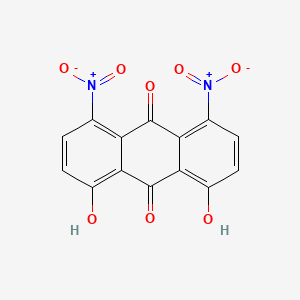D0599 | 1,8-dihydroxy-4,5-dinitroanthraquinone
| Toxicity | Dose | Time | Species | Model | Method | Action | Positive criterion | Reference |
|---|---|---|---|---|---|---|---|---|
| MEMBRANE POTENTIAL | 0.07±0.04 | human | qHTS-HepG2 | MMP assay | decrease | IC50 | 163 | |
| MEMBRANE POTENTIAL | 0.45 | human | HepG2 | MMP assay | decrease | IC50 | 163 | |
| MEMBRANE POTENTIAL | 5.69±2.62 | rat | hepatocytes | MMP assay | decrease | IC50 | 163 | |
| Pictogram | Signal | Statements | Precautionary Statement Codes |
|---|---|---|---|
 |
Warning |
Aggregated GHS information provided by 74 companies from 4 notifications to the ECHA C&L Inventory. Each notification may be associated with multiple companies. Reported as not meeting GHS hazard criteria by 31 of 74 companies. For more detailed information, please visit ECHA C&L website Of the 3 notification(s) provided by 43 of 74 companies with hazard statement code(s): H315 (100%): Causes skin irritation [Warning Skin corrosion/irritation] H319 (100%): Causes serious eye irritation [Warning Serious eye damage/eye irritation] H335 (97.67%): May cause respiratory irritation [Warning Specific target organ toxicity, single exposure Respiratory tract irritation] Information may vary between notifications depending on impurities, additives, and other factors. The percentage value in parenthesis indicates the notified classification ratio from companies that provide hazard codes. Only hazard codes with percentage values above 10% are shown. |
P261, P264, P271, P280, P302+P352, P304+P340, P305+P351+P338, P312, P321, P332+P313, P337+P313, P362, P403+P233, P405, and P501; (The corresponding statement to each P-code can be found at the GHS Classification page.) |
| 0-08-00-00460 (Beilstein Handbook Reference) | 1,8-DIHYDROXY-4,5-DINITROANTHRAQUINONE | 1,8-Dihydroxy-4,5-dinitro Anthraquinone |
| 1,8-Dihydroxy-4,5-dinitro-9,10-anthracenedione | 1,8-Dihydroxy-4,5-dinitroanthra-9,10-quinone | 1,8-Dihydroxy-4,5-dinitroanthra-9,10-quinone # |
| 1,8-Dihydroxy-4,5-dinitroanthracene-9,10-dione | 1,8-Dihydroxy-4,5-dinitroanthraquinone, 97% | 1,8-Dinitro-4,5-dihydroxyanthraquinone |
| 1,8-dihydroxy-4,5-dinitro-9,10-dihydroanthracene-9,10-dione | 1,8-dihydroxy-4,5-dinitro-anthraquinone | 4,5-Dihydroxy-1,8-dinitroanthraquinone |
| 4,5-Dinitrochrysazin | 4,5-dihydroxy-1,8-dinitroanthracene-9,10-dione | 4,5-dinitro-1,8-dihydroxyanthraquinone |
| 4,8-dinitroanthraquinone | 81-55-0 | 9, 1,8-dihydroxy-4,5-dinitro- |
| 9,10-Anthracenedione, 1,8-dihydroxy-4,5-dinitro- | 9,10-Anthracenedione,1,8-dihydroxy-4,5-dinitro- | AC-11721 |
| ACMC-1BJN5 | AI3-62955 | AKOS015856377 |
| ANW-37450 | AS-67364 | Anthraquinone, 1,8-dihydroxy-4,5-dinitro- |
| Anthraquinone,8-dihydroxy-4,5-dinitro- | BRN 2182054 | C-58056 |
| CAS-81-55-0 | CCRIS 4796 | CHEMBL1535689 |
| CTK5E8896 | Chrysazin, 4,5-dinitro- | D2697 |
| DB-056537 | DSSTox_CID_5076 | DSSTox_GSID_25076 |
| DSSTox_RID_77653 | DTXSID0025076 | EINECS 201-360-3 |
| FT-0631367 | GJCHQJDEYFYWER-UHFFFAOYSA-N | HEO6302D6D |
| InChI=1/C14H6N2O8/c17-7-3-1-5(15(21)22)9-11(7)14(20)12-8(18)4-2-6(16(23)24)10(12)13(9)19/h1-4,17-18; | KS-0000123X | LS-1810 |
| MCULE-8146603673 | MFCD00019149 | NCGC00091217-01 |
| NCGC00091217-02 | NCGC00091217-03 | NCGC00091217-04 |
| NCGC00258279-01 | NCI-C-60742 | NCI-C60742 |
| NSC 81256 | NSC-81256 | NSC81256 |
| Q-200091 | Q27279889 | SBB006491 |
| SC-78067 | SCHEMBL186885 | SR-01000323862 |
| SR-01000323862-1 | ST057725 | TR-025627 |
| Tox21_200725 | UNII-3HM851OD2N component GJCHQJDEYFYWER-UHFFFAOYSA-N | UNII-HEO6302D6D |
| V0438 | WLN: L C666 BVIVJ DQ GNW KNW NQ | ZINC4786935 |
| CAS Number | 81-55-0 |
| PubChem Compound | 3378440 |

